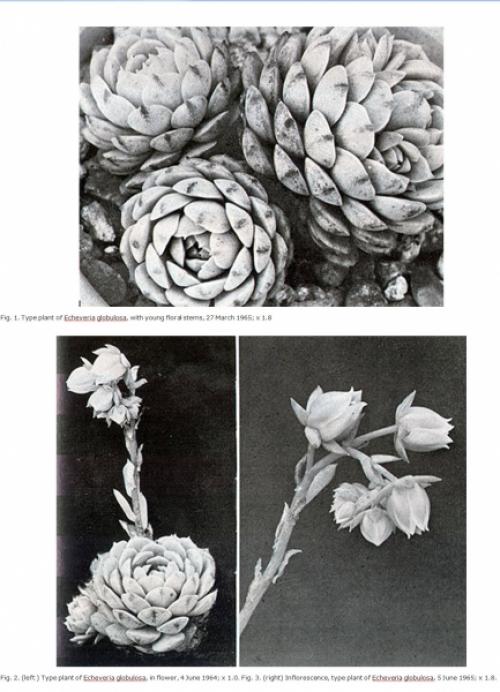GLOBULOSA Moran, 1966 (engl./ fr.)
NOT IN CULTIVATION. NEVER BEEN FOUND IN THE WILD.
The name globulosa has been given to a plant bought in a market in Oaxaca. It has never been found in the wild. That means it is a plant from cultivation.
According to the Code, the name of a plant is fixed to its type. The type in this case is a plant from cultivation with unknown origin. That means the name belongs solely to this single plant described by Reid Moran in 1966. The name cannot be used for any other plant, even if it is resembling.
Moran's plant has never been distributed and has not survived.
Thomas MacDougall who has sent this plant to Reid Moran does not even list it on his plant lists !
Series Ciliatae
Type : Tom MacDougall B-235, bought in the market in Oaxaca; said to be from near Carrizal at 9’000 to 10’000 feet elevation, District of Tlacolula, Oaxaca, Mexico. CAS 833552 (new 0002436).
Etymology : Named for the globular rosettes.
Distribution: Never been found in the wild.
First Description by Reid Moran in Cactus and Succulent Journal US 38(1) : 12-14. 1966 :
Plant glabrous.
Caudex short, errect, tan, to 9 mm thick, densely covered with dried leaves, producing offsets just below and at outer margin of rosette.
Rosettes depressed-globose, dense, 4 – 5.5 cm wide, of 50 – 60 leaves.
Rosette leaves cuneate-spatulate, obtuse to subtruncate, mucronate, 2 – 2.5 cm long, 9 – 12 mm wide above, 3 – 4 mm wide at the base, 4 – 4.5 mm thick, glaucous, often becoming red-margined and somewhat red-mottled dorsally especially on the keel, convex ventrally, rounded and faintly keeled dorsally, the margins acute, the veins mostly converging to a single strand at the base.
Floral stems 6 – 8 cm tall to the inflorescence, 2 – 3 mm thick at the base, bright red but glaucous and thus appearing deep pink, leafy to the base, with 15 – 20 ascending leaves.
Stem leaves oblong-oblanceolate, boadly acute, subapiculate, somewhat ventrally attached and spurred, 10 – 16 mm long, 3 6 mm wide, to 2.5 mm thick, convex ventrally, more convex and faintly keeled dorsally, the margins acute, the spur short, whitish, 1 – 3-thoothed.
Cincinnus solitary, circinate, of 8 – 10 flowers, which open ca 20° below the horizontal and become nearly erect.
Pedicels 7 – 12 mm long, 1 – 1.5mm thick, red.
Flowers in May and June,opening at intervals of ca 5 days, each for about two weeks.
Calyx disk 4 – 6 mm wide, umbilicate and grooved below the sinuses, the segments slightly ascending, nearly equal, slightly imbricate at the base, elliptic to narrow-ovate, acute, apiculate, 6 – 9 mm long, 3 – 5 mm wide, 1 – 2 mm thick, glaucous, often red-mottled dorsally, biconvex, the margins acute.
Corolla in bud subglobose, in flower pentagonal-ovoid with the sides channeled sometimes to a depth of 1-5 mm, 9 – 12 mm long, 7.5 – 10 mm wide near base, 5 – 6 mm wide at the apex, near watermelon pink except at the upper edges, where dandelion yellow narrowly on outer petals and more broadly on inner petals covered in bud, yellow inside. Petals non-convolute, connate 3 – 4 mm, oblong-oblanceolate, broadly acute, dorsally mucronate, 4 – 5 mm wide, rounded-keeled with flanks concave, 2 – 3 mm thick overall but ventrally channeled deeper than thickness of filaments, with convex shoulders towards the base, the nectar pit 1.5 – 2 mm long and wide, ca 1 mm deep.
Cytology : n = 24
Note :
None of the four photos on p. 125 & 126 in Pilbeam, The genus Echeveria, 2008, is correct :
Fig. 145 shows the flowers of E. derenbergii.
Fig. 146 shows the hybrid E. ‘Dondo’.
Fig. 147 & 148 show a hairy plant – again not E. globulosa which is glabrous and glaucous – clearly a hybrid with a hairy E. species.
Plants distributed as E. globulosa very often are the hybrid E. ‘Vincent Catto’ or the species E. minima.
Link to summaries of the above description in English and French.

Photos by Reid Moran accompanying the First Description in Cact. & Succ. Journal US, 39:12, 1967